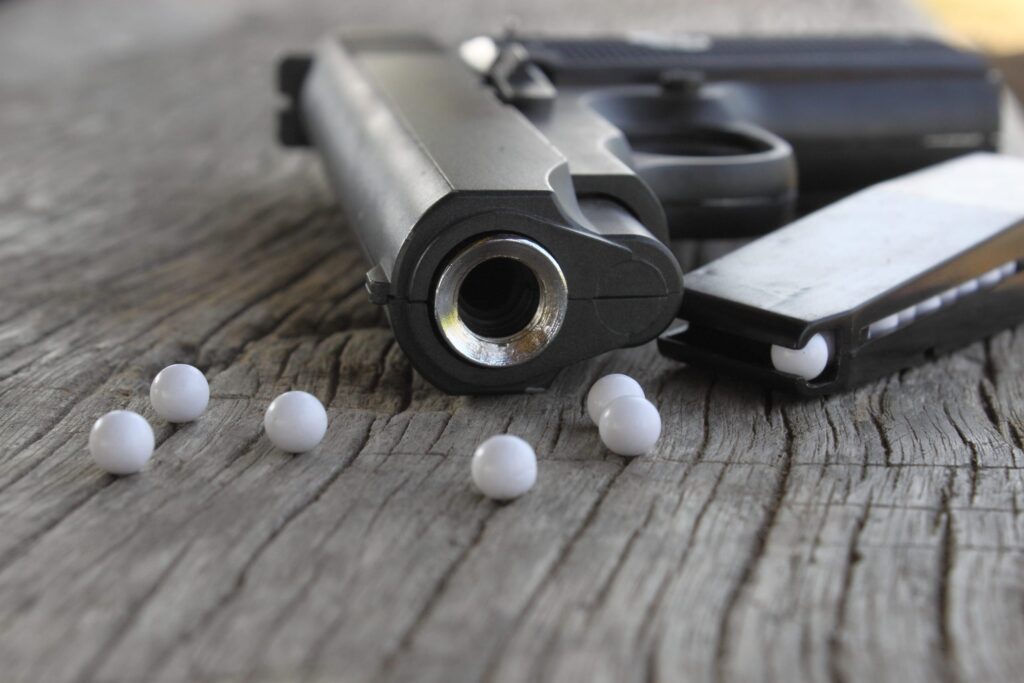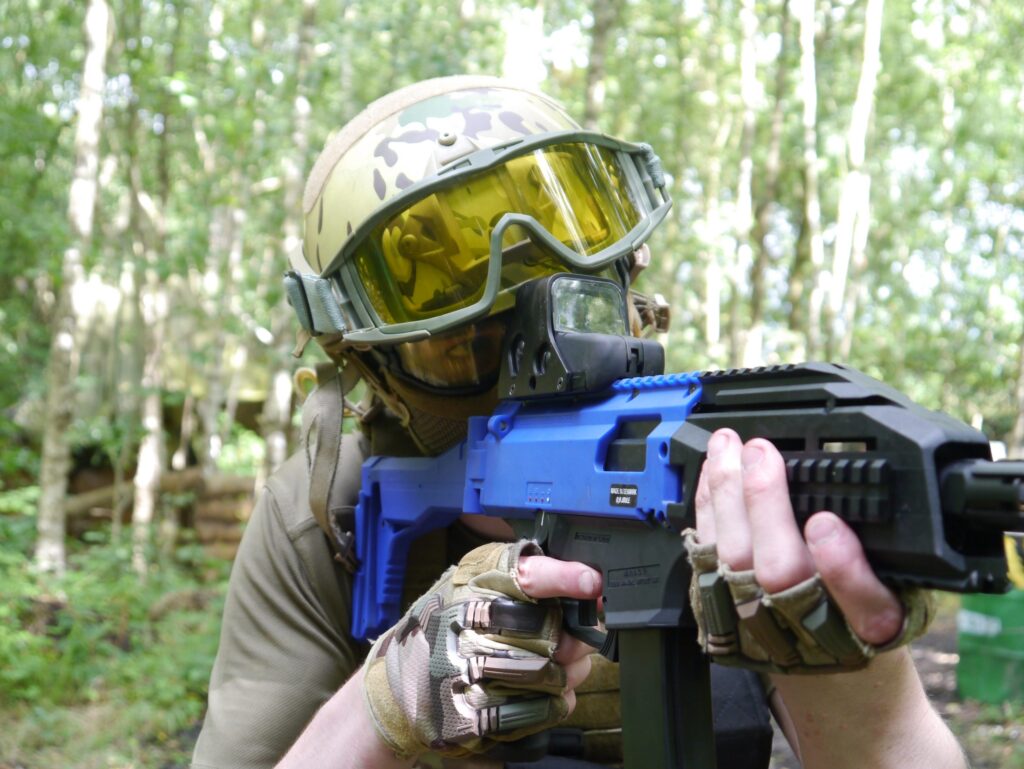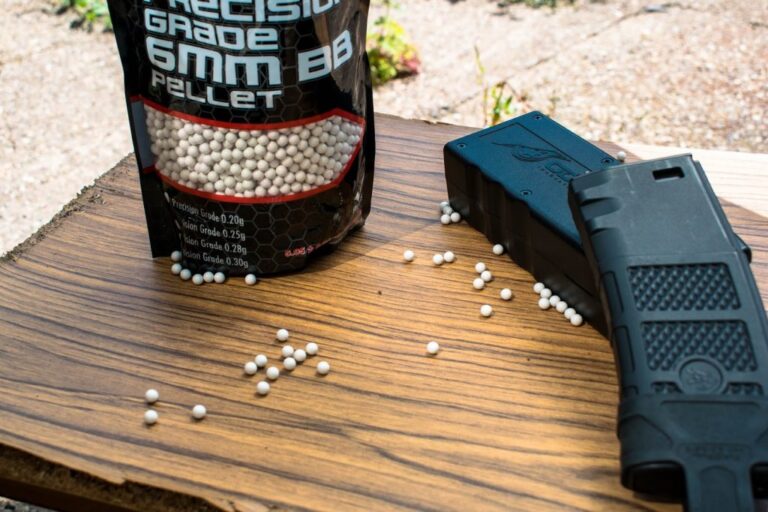Airsoft guns shoot small plastic pellets called BBs. These guns, often resembling real firearms, are used for fun activities like target practice and military-style games. Federal law doesn’t treat them as firearms, but they must be sold with an orange tip on the muzzle to distinguish them from real guns.
State laws about keeping the orange tip can vary. In Arizona, there are no specific state laws regulating the sale of airsoft guns.
Here, you will explore the characteristics and purpose of the projectiles these guns discharge, shedding light on the world of airsoft and its distinct features.
What is an Airsoft Gun?
An airsoft gun is a replica toy gun designed for use in airsoft sports, a recreational and competitive shooting activity. These special low-power smoothbore air guns shoot non-metallic spherical projectiles, commonly referred to as “BBs.”
In addition, these projectiles are typically made of plastic or biodegradable resin materials. Airsoft guns are distinct from conventional airguns due to their low muzzle energy ratings, generally less than 1.5 J (joules) or 1.1 ft-lb (foot-pounds), and have less penetrative and stopping power. They are considered safe for sporting and recreational use when proper protective gear is worn.
Components of Airsoft Guns

The components them can vary based on the type and model, but here is a general breakdown of the common components found in most airsoft guns:
- Outer Structure:
- Barrel: The tube through which the BB (ball bearing) travels when fired.
- Receiver: The main body of the gun that houses internal components.
- Stock: The rear portion of the gun that provides support against the shooter’s shoulder.
- Handguard/Grip: The front part of the gun that the shooter holds onto for stability.
- Internal Mechanism:
- Gearbox: Found in electric-powered airsoft guns (AEGs), it contains gears and a piston that controls the firing mechanism.
- Spring: Found in spring-powered guns, it provides the force to propel the BB.
- Gas System: Found in gas-powered guns, it controls the release of compressed gas to propel the BB.
- Trigger Mechanism:
- Trigger: Activates the firing mechanism when pulled.
- Safety: A mechanism to prevent accidental firing.
- Magazine:
- Magazine Well: The opening where the magazine is inserted.
- Magazine: Holds the BBs and is inserted into the gun for feeding during firing.
- Sights:
- Front Sight: Aiming point at the front of the gun.
- Rear Sight: Aiming point at the back of the gun.
- Hop-Up System:
- Hop-Up Unit: Adjusts the backspin on the BB for improved range and accuracy.
- Hop-Up Adjustment: A feature to control the amount of backspin applied to the BB.
- Muzzle:
- Muzzle Brake/Flash Hider: Attachment at the end of the barrel for aesthetics or to house additional features.
- Stock Adjustments:
- Adjustable Stock: Some models have stocks that can be adjusted for length.
- Rails and Mounting Points:
- Picatinny Rails: Attachment points for accessories like scopes, flashlights, or grips.
- Sling Mounts: Points to attach slings for carrying.
- Battery Compartment (for AEGs):
- Battery Housing: Compartment for holding the rechargeable battery in electric-powered guns.
- Gas Reservoir (for Gas-powered Guns):
- Gas Chamber: Holds the compressed gas used to propel the BB.
Types of Airsoft Guns
1. Spring-powered:
- Single-shot devices using a compressed coil spring to propel a pellet.
- Manual operation requires the user to recompress the spring before each shot.
- Generally less powerful than gas-powered guns but more powerful than electric ones.
- Inexpensive and often used as entry-level or training guns.
2. Battery-powered (Automatic Electric Guns – AEGs):
- Use a rechargeable battery to power an internal electric motor that compresses a pump spring and propels pellets.
- Selective fire options, including automatic, 3-round burst, and semi-automatic.
- The most popular and accessible kind of airsoft rifle.
- Popular models include AR-15 series, H&K MP5 series, AK series, and others.
Subcategories:
- Low-powered electric guns (LPEGs): Lower-cost and less powerful AEGs.
- Medium-priced electric guns (MPEGs): Improved quality AEGs at a more affordable price.
- Electric blowbacks (EBBs): AEGs simulate the blowback action of real firearms.
3. Gas-powered:
- Capable of both automatic and semi-automatic operation.
- Common gases include CO2, red gas, and HFC-134a.
- Pellets should be propelled by compressed gas, often known as “green gas” or propane.
- Gas blowback (GBB) firearms load the next shot cyclically while simulating recoil.
4. High-pressure air systems (HPA):
- Instead of using internal gas canisters, use high-pressure air that is supplied externally.
- Connected to the airsoft gun with a hose and features adjustable rates of fire.
- Brands include PolarStar, Wolverine, Valken, and Tippmann.
5. Hybrid guns:
- GBB hybrids simulate recoil and use shell casings for pellets.
- Incorporate GBB or AEG gun parts for more realism.
- Shell cases and caps are used by AEG hybrids to create realistic smoke and sound effects.
Usage and Applications
- Recreational Use:
- Airsoft is widely used for recreational purposes, with clubs, teams, and athletic associations hosting events worldwide.
- Large-scale events in Europe and North America attract thousands of participants, creating intense and varied gameplay.
- Training Tool:
- In 2012, gas blowback (GBB) airsoft technology gained adoption by US federal and state institutions as a cost-effective and reliable tactical training tool for close-quarters battles.
- The United States Coast Guard officially adopted SIG-branded P229 airsoft pistols for training in 2018.
- Military and Law Enforcement Training:
- Airsoft guns, such as those produced by Systema Engineering and Celsius Technology, offer realistic high-velocity rifles designed for non-lethal training purposes.
- Systema Engineering developed a line for military and law enforcement training, providing a more authentic display of military weapons.
- Film Prop Use:
- They are utilized as props in filmmaking due to their realistic appearance.
Legal Considerations
In many countries, airsoft gun owners and enthusiasts must be affiliated with an accredited airsoft association or federation.
Two-Tone Guns: In the UK, airsoft Two-Tone guns are replicas sprayed over 51% in a bright, non-military color to comply with the Violent Crimes Reduction Act (VCRA) of 2006.
Performance:
Airsoft guns come in a range of velocities, from low-end spring pistols at 30 m/s (98 ft/s) to heavily upgraded sniper rifles at 200 m/s (660 ft/s). Upgrading internal components and using different pellet weights can significantly impact performance.
Moreover, the hop-up system, found in many guns, imparts a backspin for a flatter trajectory. Safety measures such as eye protection are crucial, with velocities capable of causing injury. Strict velocity limits are enforced in indoor and outdoor fields to ensure player safety.
Safety:
Proper protective gear is essential in airsoft to prevent injuries. Full-seal protective eyewear meeting or exceeding ANSI/ISEA Z87.1 standards is a minimum requirement. Legal regulations exist to govern airsoft, including velocity limits and engagement distances. The use of metallic BBs is discouraged due to safety risks. Concerns such as “pumping” or intentionally firing multiple rounds at one player have led to rules promoting fair play.
Police Shootings:
Several incidents involving them and law enforcement highlight the potential dangers. Instances where individuals carrying airsoft guns were mistaken for real firearms resulted in tragic outcomes. These incidents emphasize the need for responsible use and proper identification of airsoft replicas.
Trademark Problems:

Accurate replicas of real firearms can lead to trademark violations. Some companies license trademarks from firearm manufacturers to avoid legal issues. Trademark holders, such as Glock and Heckler & Koch, may take legal action against unauthorized replicas.
Also, recent developments involve the United States Coast Guard using airsoft pistols for training, prompting changes in licensing agreements between airsoft manufacturers and firearm companies.
FAQ’s
1. What bullets do airsoft guns use?
Airsoft guns use BBs, small plastic pellets typically 6mm in diameter. These round pellets are made of plastic and come in various colors and weights, with the standard size being 6mm.
2. Is CO2 gun legal in Bangladesh?
No, The import of air guns is banned in Bangladesh. However, airguns can be imported for the use of Sports and Shooting Clubs with prior permission from the Ministry of Home Affairs.
3. What is the point of airsoft?
Airsoft is a military simulation sport where participants engage in mock combat using authentic military-style weapons and tactics. Unlike paintball, airsoft uses 6mm round BBs made of hard plastic, with guns being full-scale replicas of real-world weapons.
4. Is an airsoft gun a BB gun?
No, an airsoft gun is not a BB gun. The term “BB gun” is often misused to describe airsoft guns. Airsoft guns shoot larger plastic pellets (BBs) that are 6mm in diameter, less dense than metal BBs, and have lower ballistic performance.
5. Can 400 fps break skin?
Yes, at around 300 to 400 feet per second (fps), airsoft pellets can break the skin and cause harm. Above 350 fps is considered very harmful or lethal, posing a risk of penetration in human skin.
6. Are airsoft bullets safe?
Yes,While airsoft pellets are generally safe when used with proper protective gear, they can pose a risk of eye injury if eye protection is not worn. Pellets striking the eye can cause scratches, blood pooling, lens dislocation, or blindness. The use of paintball-style protective eyewear is recommended by health authorities.
Conclusion
Airsoft guns shoot non-lethal plastic pellets known as BBs. These small projectiles, typically 6mm or 8mm in diameter, are propelled by compressed air or gas. While resembling traditional firearms, airsoft guns are recreational devices used for target practice and simulated military-style games.
Further, federal law does not classify them as firearms but mandates the inclusion of an orange tip on the muzzle for safety. State regulations regarding the retention of this orange tip can vary, and in Arizona, there are no specific state laws governing the sale of airsoft guns.

